Contents
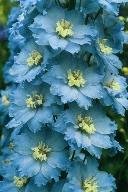
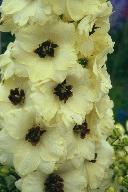
| Return to Fascinating Delphiniums Menu | Return to Home Page |
ROOTS AND BLOOMS OF CULTIVATED DELPHINIUMSAn illustrated guide to the structure of garden delphiniums Adapted by David Bassett from his article in Delphiniums '97 |
Contents |
 |
 |
The delphinium cultivars shown above are 'Blue Lagoon' and 'Celebration',
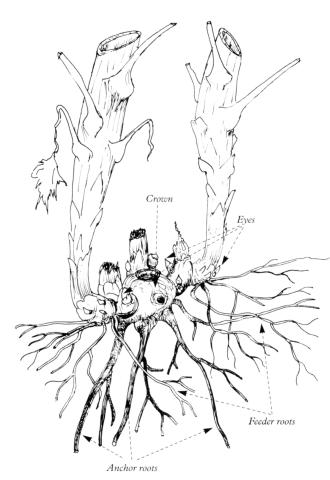 The drawing shows the features typical of a
cultivated garden delphinium's root system after three phases of
flower stem growth (2 or 3 years old).
The drawing shows the features typical of a
cultivated garden delphinium's root system after three phases of
flower stem growth (2 or 3 years old).
The current seasons flower stems grow from the basal region of the previous years stems, of which only the decaying stumps remain.
These old stems, in turn, grew from buds at the base of the original first-year flower stem. The basal region has enlarged with age, becoming a thick, woody shell that is normally hollow.
The woody basal regions of all the old stems together constitute the crown of the plant. Dormant buds, or eyes, from which new flower stems could grow, are widely distributed over the surface of the crown. It is easy to see that the base of the stems is fragile and that failure to support the flower stems can result in damage to the crown.
Roots extending from the crown supply nutrients and water for growth of the plant and two types can be distinguished.
There are anchor roots, which are thick dark brown roots extending deep into the soil (15 inches or more) from the base of the oldest part of the crown. These old roots surviving from the first years growth serve as anchors for the plant. They are crucial for survival of the plant during periods of drought or winter dormancy, when they supply water and nutrients from deep underground. Moving a mature plant always breaks the anchor roots and they do not seem to regenerate.
There are also thin, yellowish young roots spreading outwards from the crown to beyond the canopy of the leaves (18 inches or more), which are located mainly within the surface layers of the soil. These extensively-branched feeder roots grow rapidly during summer from existing roots and younger regions of the crown, including the basal regions of the growing flower stems. The uptake of nutrients and water through them determines the vigour of the plant and the quality of the flowers. Unfavourable soil conditions, such as drought after flowering or waterlogging during autumn and winter, can result in almost total loss of the feeder roots, which must then regenerate during the following season.
| Return to Contents List | Return to Fascinating Delphiniums Menu |
The main bloom is a collection of individual flowers, termed florets, more or less regularly spaced around the stem along the turns of a spiral.
Each floret is attached to the stem by a thin stalk, or pedicel. The points of floret attachment continue the sequence of leaf joints found on the lower part of the stem, with the flower developing from a bud in the leaf axil. Within the bloom, the leaves are normally reduced to a small bract. Two even smaller reduced leaves, called bracteoles, are generally present on the pedicel just behind the flower.
Changes in leaf character are also seen at leaf joints just below the bloom. The leaves become smaller and more dissected, often with only two or three segments rather than the five segments typical of lower leaves.
In addition to the group of florets forming the bloom that terminates the main stem, sideshoots with further groups of florets, usually called laterals, develop from three or more leaf axils immediately below the main bloom. The strength of these shoots varies greatly from one cultivar to another. Each lateral is like a small version of the main stem, showing the same sequence of changes in leaf form, sub-laterals and a spike of individual florets.
| Return to Contents List | Return to Fascinating Delphiniums Menu |
The overall shape of a delphinium bloom varies considerably
from one cultivar to another. This results from differences in
the length of pedicels and their angle relative to the main stem.
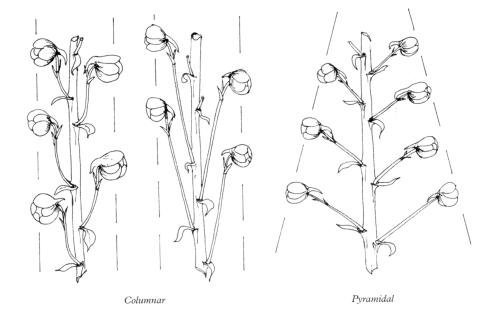
Short pedicels (2-4cm) result in the florets being held close to the main stem, giving a narrow, columnar (parallel-sided) bloom. Few named cultivars in commerce today have this type of bloom but it is found among seedlings, although most growers would reject the plants as undesirable.
Columnar blooms are also found for pedicels of any length (even 20cm) if the pedicels make only a narrow angle to the main stem. Again, there are very few cultivars in commerce today with this characteristic since columnar blooms are no longer favoured.
Cultivars with pedicels significantly longer than the floret diameter and making an angle of about 45 degrees to the main stem have blooms with a conical or pyramidal shape, that taper gradually towards the tip from a broad base. The conical form is most pronounced when the bloom is young, since there is a gradation in length of the pedicels from the base to the tip. Because the pedicels increase in length as the florets mature, the blooms approach a broad columnar form at full maturity. This is a feature of most cultivars in commerce and is characteristic of well known exhibition varieties like 'Bruce' or 'Gillian Dallas'.
| Return to Contents List | Return to Fascinating Delphiniums Menu |
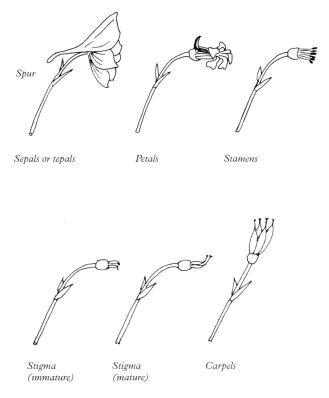 The principle components of a delphinium floret are
readily seen by taking a floret to pieces, essentially in the
sequence in which the various parts are arranged along the stalk.
The principle components of a delphinium floret are
readily seen by taking a floret to pieces, essentially in the
sequence in which the various parts are arranged along the stalk.
Starting at the back of the floret, the first group of components are the large coloured bracts that give the flowers their attractive appearance. These are sepals or tepals, although they are commonly called petals. Their function is to attract pollinators (insects/humming birds etc) to the flower. The sepal at the top of the floret has a tube extending backwards behind the flower. This characteristic spur, which gives buds the resemblance to a dolphin implied by the name delphinium, houses nectaries that also serve to attract pollinators. In a wild delphinium there are five sepals, but garden hybrids can have from five to fifty sepals!
Removing the sepals reveals the true petals that form the "eye" or "bee" of the flower. The uppermost pair are weakly joined together and extend backwards into a tubular spur that contains nectar. This pair of spurs is sheathed by the spur of the top sepal but, in cultivated plants, the petal spurs are often curved up and exposed on the face of the floret.
Removing the petals, reveals the stamens. These are the large group of small capsules called anthers that produce pollen, each mounted on a slender stalk or filament. Initially green, the anthers become black or purple at maturity and split to release pollen grains when the flower opens.
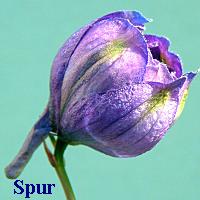 |
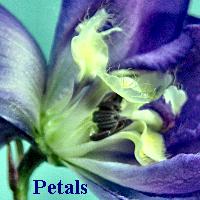 |
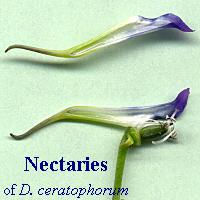 |
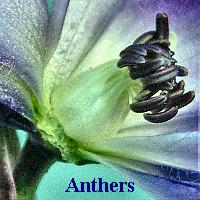 |
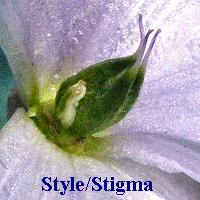 |
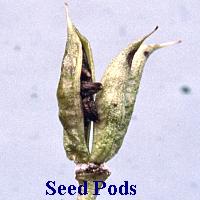 |
Removing the stamens reveals the final group of tiny cylindrical structures, which are the immature seed pods containing unfertilised ovules that will develop to seeds after pollination. At the tip of each is a fine tube, the style, that terminates in the stigma. This tube is immature and bent downwards when the flower opens. After two or three days it extends and curves upwards, with the tip opening and becoming sticky so that pollen arriving there will adhere, germinate and then fertilise the seeds.
Ater pollination, the seeds develop to maturity and the seed pods, or carpels, enlarge. The number of carpels varies with cultivar from three to five but sometimes there are ten or more. The number of seeds also varies but typically there are 10 to 15 seeds in a full pod.
| Return to Contents List | Return to Fascinating Delphiniums Menu |
The appearance of the flower depends greatly on the number of sepals and petals. The more attractive appearance of flowers with multiple sets has resulted in the selection of cultivars with larger numbers of sepals etc than a wild dephiniums and these are now the norm.
A wild-type delphinium has five sepals and the floret is said to be single. There are four petals, the upper pair being fused to form the nectary and the lower two, sometimes called "honey leaves", are normally decorated with coloured hairs. This type of flower is characteristic of belladonna hybrids, like that seen here, and of named cultivars widely grown in continental Europe.
In Britain, selection by breeders has resulted in all named cultivars in commerce, for example 'Fanfare' seen here, having more sepals and petals than wild delphiniums. The normal situation is a flower with the basic set of five sepals supplemented by an additional inner set of eight more. Such a flower is termed semi-double and it also has an increased number of petals in the eye. The number of sepals is not necessarily restricted to thirteen and flowers with up to thirty or more are not infrequent among seedlings.
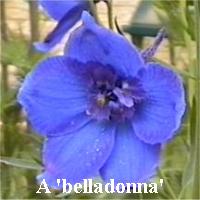 |
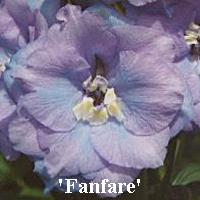 |
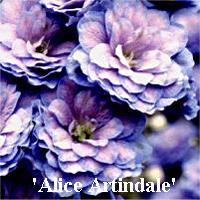 |
Sometimes eye petals are not present at all, but are replaced by a large number of extra sepals, giving double flowers. These can be exceptionally pretty, with tiered layers of sepals like a double Camellia or Ranunculus, as in the cultivar 'Alice Artindale' seen here, or unattractive open-centred flowers with the carpels exposed.
| Return to Contents List | Return to Fascinating Delphiniums Menu |
| Return to Home Page |